Desert Dust and Health: A Central Asian Review and Steppe Case Study
Abstract
1. Introduction
1.1. Regional Context: Description of Dust Sources
1.2. General Assessment of Dust-Health Interaction with a Focus on Mongolia
2. Materials and Methods
2.1. Mongolian Case Study: Context
2.2. Study Site
2.3. Dust Traps
3. Results
- Findings along unpaved sections of the Khanbogd road were mixed with low to high volumes recorded.
- Nomgon, the village furthest from the mine (75 km), had more dust than the nearer villages Javalant (16 km) or Gavaluut (20 km).
- Some sites near OT were relatively low whilst locations east of the soum centre had higher concentration.
- Results and observation suggests that the Khanbogd road has limited dust impact beyond the immediate (to 250 m) vicinity.
- Initial source of the dust was not investigated, but it is likely that several other potential dust sources exist beyond mining and related infrastructure: railway construction, coal trucks, herder vehicles, unpaved roads unrelated to OT, quarries and dirt pits, dry riverbeds, areas of livestock concentration, and herder vehicle tracks.
4. Discussion
5. Conclusions
Acknowledgments
Author Contributions
Conflicts of Interest
References
- Goudie, A.S. Desert dust and human health disorders. Environ. Int. 2014, 63, 101–113. [Google Scholar] [CrossRef] [PubMed]
- UN Shrinking Aral Sea Underscores Need for Urgent Action on Environment. 2010. Available online: http://www.un.org/apps/news/story.asp?NewsID=34276 (accessed on 4 May 2017).
- Creamean, J.M.; Spackman, J.R.; Davis, S.M.; White, A.B. Climatology of long-range transported Asian dust along the West Coast of the United States. J. Geophys. Res. Atmos. 2014, 119. [Google Scholar] [CrossRef]
- Wiggs, G.F.; O’hara, S.L.; Wegerdt, J.; Van Der Meer, J.; Small, I.; Hubbard, R. The dynamics and characteristics of aeolian dust in dryland Central Asia: Possible impacts on human exposure and respiratory health in the Aral Sea basin. Geogr. J. 2003, 169, 142–157. [Google Scholar] [CrossRef]
- O’hara, S.L.; Wiggs, G.F.; Mamedov, B.; Davidson, G.; Hubbard, R.B. Exposure to airborne dust contaminated with pesticide in the Aral Sea region. Lancet 2000, 355, 627–628. [Google Scholar] [CrossRef]
- Gupta, A.; Gupta, A. Environmental challenges in Aral Sea basin: Impact on Human health. Int. J. Res. Soc. Sci. 2016, 6, 419–440. [Google Scholar]
- Griffin, D.W. Atmospheric movement of microorganisms in clouds of desert dust and implications for human health. Clin. Microbial. Rev. 2007, 20, 459–477. [Google Scholar] [CrossRef] [PubMed]
- Goudie, A.; Middleton, N.J. Desert Dust in the Global System, 1st ed.; Springer Science & Business Media: Berlin, Germany, 2006; ISBN 978-3-540-32355-6. [Google Scholar]
- Gao, H.; Washington, R. The spatial and temporal characteristics of TOMS AI over the Tarim Basin, China. Atmos. Environ. 2009, 43, 1106–1115. [Google Scholar] [CrossRef]
- Hashizume, M.; Ueda, K.; Nishiwaki, Y.; Michikawa, T.; Onozuka, D. Health effects of Asian dust events: A review of the literature. Nihon Eiseigaku Zasshi. Jpn. J. Hyg. 2010, 65, 413–421. [Google Scholar] [CrossRef]
- Mohammat, A.; Wang, X.; Xu, X.; Peng, L.; Yang, Y.; Zhang, X.; Myneni, R.B.; Piao, S. Drought and spring cooling induced recent decrease in vegetation growth in Inner Asia. Agric. For. Meteorol. 2013, 178, 21–30. [Google Scholar] [CrossRef]
- Lioubimtseva, E.; Henebry, G.M. Climate and environmental change in arid Central Asia: Impacts, vulnerability, and adaptations. J. Arid Environ. 2009, 73, 963–977. [Google Scholar] [CrossRef]
- Orlovsky, L.; Indoitu, R.; Kozhoridze, G.; Batyrbaeva, M.; Vitkovskaya, I.; Mamedov, B.; Orlovsky, N. Temporal and spatial distributions of dust storms in Middle Asia. In Climate Hazard Crises in Asian Societies and Environments; Sternberg, T., Ed.; Routledge: Abingdon, UK, 2017. [Google Scholar]
- Atwood, C.P. Is There such a thing as Central/Inner (Eur) Asia and is Mongolia a part of it? In Mapping Mongolia: Situating Mongolia in the World from Geologic Time to the Present; Sabloff, P.L., Ed.; University of Pennsylvania Press: Philadelphia, PA, USA, 2011. [Google Scholar]
- ESCR (Economic, Social & Cultural Rights) Mining and Communities: Mongolian Herders Complain against Rio Tinto over Oyu Tolgoi Mines. 2012. Available online: http://www.escr-net.org/node/365339 (accessed on 15 August 2017).
- Lyriak. Central Asia Borders. 2008. Available online: http://cs.mcgill.ca/~rwest/wikispeedia/wpcd/images/253/25390.png (accessed on 1 August 2017).
- Prospero, J.M.; Ginoux, P.; Torres, O.; Nicholson, S.E.; Gill, T.E. Environmental characterization of global sources of atmospheric soil dust identified with the Nimbus 7 Total Ozone Mapping Spectrometer (TOMS) absorbing aerosol product. Rev. Geophys. 2002, 40. [Google Scholar] [CrossRef]
- Gao, H.; Washington, R. Arctic oscillation and the interannual variability of dust emissions from the Tarim Basin: A TOM AI based study. Clim. Dyn. 2010, 35, 511–522. [Google Scholar] [CrossRef]
- Kes, A.S.; Fedorovich, B.A. Process of forming of aeolian dust in space and time 1976. In Proceedings of the 23rd International Geographical Congress, Moscow, Russia, 22 July 1976; pp. 174–177. [Google Scholar]
- Shao, Y.; Wang, J.A. Climatology of Northeast Asian dust events. Meteorol. Z. 2003, 12, 187–196. [Google Scholar] [CrossRef]
- Indoitu, R.; Orlovsky, L.; Orlovsky, N. Dust storms in Central Asia: Spatial and temporal variations. J. Arid Environ. 2012, 85, 62–70. [Google Scholar] [CrossRef]
- Miller, R.L.; Tegen, I.; Perlwitz, J. Surface radiative forcing by soil dust aerosols and the hydrologic cycle. J. Geophys. Res. Atmos. 2004, 109. [Google Scholar] [CrossRef]
- Tanaka, T.Y.; Chiba, M. A numerical study of the contributions of dust source regions to the global dust budget. Glob. Planet. Chang. 2012, 52, 88–104. [Google Scholar] [CrossRef]
- Lei, H.; Wang, J.X.L. Observed characteristics of dust storm events over the western United States using meteorological, satellite, and air quality measurements. Atmos. Chem. Phys. 2014, 14, 7847–7857. [Google Scholar] [CrossRef]
- Qin, B. A preliminary investigation of lake evolution in 20-century in inland mainland Asia with relation to the global warming. J. Lake Sci. 1999, 11, 11–19. [Google Scholar]
- Shen, H.; Abuduwaili, J.; Samat, A.; Ma, L. A review on the research of modern aeolian dust in Central Asia. Arab. J. Geosci. 2016, 9, 625. [Google Scholar] [CrossRef]
- Buseck, P.R.; Pósfai, M. Airborne minerals and related aerosol particles: Effects on climate and the environment. Proc. Natl. Acad. Sci. USA 1999, 96, 3372–3379. [Google Scholar] [CrossRef] [PubMed]
- Chen, J.; Li, G. Geochemical studies on the source region of Asian dust. Sci. China Earth Sci. 2011, 54, 1279–1301. [Google Scholar] [CrossRef]
- Ling, H.F.; Jiang, S.Y.; Frank, M.; Zhou, H.Y.; Zhou, F.; Lu, Z.L.; Ge, C.D. Differing controls over the Cenozoic Pb and Nd isotope evolution of deepwater in the central North Pacific Ocean. Earth Planet. Sci. Lett. 2011, 232, 345–361. [Google Scholar] [CrossRef]
- Jacobson, A.D.; Holmden, C. Calcite dust and the atmospheric supply of Nd to the Japan Sea. Earth Planet. Sci. Lett. 2006, 244, 418–430. [Google Scholar] [CrossRef]
- Rao, W.; Chen, J.; Yang, J.; Ji, J.; Zhang, G. Sr isotopic and elemental characteristics of calcites in the Chinese deserts: Implications for eolian Sr transport and seawater Sr evolution. Geochim. Cosmochim. Acta 2009, 73, 5600–5618. [Google Scholar] [CrossRef]
- Zheng, M.; Salmon, L.G.; Schauer, J.J.; Zeng, L.; Kiang, C.S.; Zhang, Y.; Cass, G.R. Seasonal trends in PM2.5 source contributions in Beijing, China. Atmos. Environ. 2005, 39, 3967–3976. [Google Scholar] [CrossRef]
- Biscaye, P.E.; Grousset, F.E.; Revel, M.; Van der Gaast, S.; Zielinski, G.A.; Vaars, A.; Kukla, G. Asian provenance of glacial dust (stage 2) in the Greenland Ice Sheet Project 2 ice core, Summit, Greenland. J. Geophys. Res. Oceans 1997, 102, 26765–26781. [Google Scholar] [CrossRef]
- Shen, Z.; Li, X.; Cao, J.; Caquineau, S.; Wang, Y.; Zhang, X. Characteristics of clay minerals in Asian dust and their environmental significance. China Particuol. 2005, 3, 260–264. [Google Scholar] [CrossRef]
- Li, G.; Chen, J.; Ji, J.; Yang, J.; Conway, T.M. Natural and anthropogenic sources of East Asian dust. Geology 2009, 37, 727–730. [Google Scholar] [CrossRef]
- Nakano, T.; Yokoo, Y.; Nishikawa, M.; Koyanagi, H. Regional Sr-Nd isotopic ratios of soil minerals in northern China as Asian dust fingerprints. Atmos. Environ. 2004, 38, 3061–3067. [Google Scholar] [CrossRef]
- Lee, M.K.; Lee, Y.I.; Yi, H.I. Provenances of atmospheric dust over Korea from Sr-Nd isotopes and rare earth elements in early 2006. Atmos. Environ. 2010, 44, 2401–2414. [Google Scholar] [CrossRef]
- Mahowald, N.M.; Luo, C. A less dusty future? Geophys. Res. Lett. 2003, 30. [Google Scholar] [CrossRef]
- Wang, J.X. Mapping the global dust storm records: Review of dust data sources in supporting modeling/climate study. Curr. Pollut. Rep. 2015, 1, 82–94. [Google Scholar] [CrossRef]
- Natsagdorj, L.; Jugder, D.; Chung, Y.S. Analysis of dust storms observed in Mongolia during 1937–1999. Atmos. Environ. 2003, 37, 1401–1411. [Google Scholar] [CrossRef]
- Middleton, N.J. Desert dust hazards: A global review. Aeolian Res. 2017, 24, 53–63. [Google Scholar] [CrossRef]
- Orlovsky, N.S.; Orlovsky, L.; Indoitu, R. Severe dust storms in Central Asia. Arid Ecosyst. 2013, 3, 227–234. [Google Scholar] [CrossRef]
- Orlovsky, L.; Orlovsky, N.; Durdyev, A. Dust storms in Turkmenistan. J. Arid Environ. 2005, 60, 83–97. [Google Scholar] [CrossRef]
- Yao, Z.; Xiao, J.; Li, C.; Zhu, K. Regional characteristics of dust storms observed in the Alxa Plateau of China from 1961 to 2005. Environ. Earth Sci. 2011, 64, 255–267. [Google Scholar] [CrossRef]
- Guo, G.; Xie, G. Technical note: Dust storms in China decreased during the last 50 years. Int. J. Remote Sens. 2008, 29, 1619–1620. [Google Scholar] [CrossRef]
- Lee, E.H.; Sohn, B.J. Recent increasing trend in dust frequency over Mongolia and Inner Mongolia regions and its association with climate and surface condition change. Atmos. Environ. 2011, 45, 4611–4616. [Google Scholar] [CrossRef]
- Xu, J. Sand-dust storms in and around the Ordos Plateau of China as influenced by land use change and desertification. Catena 2006, 65, 279–284. [Google Scholar] [CrossRef]
- Kurosaki, Y.; Shinoda, M.; Mikami, M.; Nandintsetseg, B. Effects of soil and land surface conditions in summer on dust outbreaks in the following spring in a Mongolian grassland. SOLA 2011, 7, 69–72. [Google Scholar] [CrossRef]
- Yang, Y.Q.; Hou, Q.; Zhou, C.H.; Liu, H.L.; Wang, Y.Q.; Niu, T. Sand/dust storm processes in Northeast Asia and associated large-scale circulations. Atmos. Chem. Phys. 2008, 8, 25–33. [Google Scholar] [CrossRef]
- Wang, X.; Eerdun, H.; Zhou, Z.; Liu, X. Significance of variations in the wind energy environment over the past 50 years with respect to dune activity and desertification in arid and semiarid northern China. Geomorphology 2007, 86, 252–266. [Google Scholar] [CrossRef]
- Kraemer, R.; Prishchepov, A.V.; Müller, D.; Kuemmerle, T.; Radeloff, V.C.; Dara, A.; Frühauf, M. Long-term agricultural land-cover change and potential for cropland expansion in the former Virgin Lands area of Kazakhstan. Environ. Res. Lett. 2015, 10, 054012. [Google Scholar] [CrossRef]
- Saiko, T.A.; Zonn, I.S. Irrigation expansion and dynamics of desertification in the Circum-Aral region of Central Asia. Appl. Geogr. 2000, 20, 349–367. [Google Scholar] [CrossRef]
- Sternberg, T. Water megaprojects in deserts and drylands. Int. J. Water Resour. Dev. 2016, 32, 301–320. [Google Scholar] [CrossRef]
- Kravtsova, V.I.; Tarasenko, T.V. Space monitoring of Aral Sea degradation. Water Resour. 2010, 37, 285–296. [Google Scholar] [CrossRef]
- Staecker. Orphaned Ship in Former Aral Sea, near Aral, Kazakhstan. 2003. Available online: commons.wikimedia.org/wiki/File:Aralship2.jpg (accessed on 1 November 2017).
- Zhang, B.; Tsunekawa, A.; Tsubo, M. Identification of dust hot spots from multi-resolution remotely sensed data in eastern China and Mongolia. Water Air Soil Pollut. 2015, 226, 117. [Google Scholar] [CrossRef]
- Jugder, D. Hydrodynamic-Statistics Model for Prediction of Wind, Snow Storms and Dust Storms over the Territory of Mongolia. Ph.D. Thesis, National University of Mongolia, Ulaanbaatar, Mongolia, 1999; pp. 3–30. [Google Scholar]
- Yumimoto, K.; Takemura, T. Long-term inverse modelling of Asian dust: Interannual variations of its emission, transport, deposition, and radiative forcing. J. Geophys. Res. Atmos. 2015, 120, 1582–1607. [Google Scholar] [CrossRef]
- Engelbrecht, J.P.; Derbyshire, E. Airborne mineral dust. Elements 2010, 6, 241–246. [Google Scholar] [CrossRef]
- Groll, M.; Opp, C.; Aslanov, I. Spatial and temporal distribution of the dust deposition in Central Asia–Results from a long term monitoring program. Aeolian Res. 2013, 9, 49–62. [Google Scholar] [CrossRef]
- Sicard, M.; Rocadenbosch, F.; Reba, M.N.M.; Comerón, A.; Tomás, S.; García-Vízcaino, D.; Baldasano, J.M. Seasonal variability of aerosol optical properties observed by means of a Raman lidar at an EARLINET site over North-eastern Spain. Atmos. Chem. Phys. 2011, 11, 175–190. [Google Scholar] [CrossRef]
- Geravandi, S.; Goudarzi, G.; Mohammadi, M.J.; Taghavirad, S.S.; Salmanzadeh, S. Sulfur and nitrogen dioxide exposure and the incidence of health endpoints in Ahvaz, Iran. Health Scope 2015, 4, e24318. [Google Scholar] [CrossRef]
- U.S. Environmental Protection Agency. Integrated Science Assessment (ISA) for Particulate Matter (Final Report, December 2009); U.S. EPA: Washington, DC, USA, 2009. [Google Scholar]
- Kenessariyev, U.; Golub, A.; Brody, M.; Dosmukhametov, A.; Amrin, M.; Erzhanova, A.; Kenessary, D. Human health cost of air pollution in Kazakhstan. J. Environ. Prot. 2013, 4, 869. [Google Scholar] [CrossRef]
- Jadambaa, A.; Spickett, J.; Badrakh, B.; Norman, R.E. The impact of the environment on health in Mongolia: A systematic review. Asia Pac. J. Public Health 2015, 27, 45–75. [Google Scholar] [CrossRef] [PubMed]
- Brauer, M.; Ebelt, S.T.; Fisher, T.V.; Brumm, J.; Petkau, A.J.; Vedal, S. Exposure of chronic obstructive pulmonary disease patients to particles: Respiratory and cardiovascular health effects. J. Expo. Sci. Environ. Epidemiol. 2001, 11, 490. [Google Scholar] [CrossRef] [PubMed]
- Yang, Z.H.; Meng, Z.Q.; Zhang, Q.X. Association of inhalable particles in dust events with daily outpatient visits for Tracheitis. J. Environ. Occup. Med. 2013, 30, 88–92. [Google Scholar]
- Unanue, E.R. The regulatory role of macrophages in antigenic stimulation part two: Symbiotic relationship between lymphocytes and macrophages. Adv. Immunol. 1981, 31, 1–136. [Google Scholar] [PubMed]
- World Health Organization. Hazard Prevention and Control in the Work Environment: Airborne Dust 1999; WHO: Geneva, Switzerland, 2005. [Google Scholar]
- Brook, R.D.; Rajagopalan, S.; Pope, C.A.; Brook, J.R.; Bhatnagar, A.; Diez-Roux, A.V.; Peters, A. Particulate matter air pollution and cardiovascular disease. Circulation 2010, 121, 2331–2378. [Google Scholar] [CrossRef] [PubMed]
- Martinelli, N.; Olivieri, O.; Girelli, D. Air particulate matter and cardiovascular disease: A narrative review. Eur. J. Intern. Med. 2013, 24, 295–302. [Google Scholar] [CrossRef] [PubMed]
- Khaniabadi, Y.O.; Goudarzi, G.; Daryanoosh, S.M.; Borgini, A.; Tittarelli, A.; De Marco, A. Exposure to PM10, NO2, and O3 and impacts on human health. Environ. Sci. Pollut. Res. 2017, 24, 2781–2789. [Google Scholar] [CrossRef] [PubMed]
- Chen, W.; Liu, Y.; Wang, H.; Hnizdo, E.; Sun, Y.; Su, L.; Chen, J. Long-term exposure to silica dust and risk of total and cause-specific mortality in Chinese workers: A cohort study. PLoS Med. 2012, 9, e1001206. [Google Scholar] [CrossRef] [PubMed]
- Ma, Z.; Chen, K.; Li, Z.; Bi, J.; Huang, L. Heavy metals in soils and road dusts in the mining areas of Western Suzhou, China: A preliminary identification of contaminated sites. J. Soils Sediments 2016, 16, 204–214. [Google Scholar] [CrossRef]
- Andrade, P.C.C.; da Luz, J.A.M.; Campos, A.S.; de Lima, H.M. Cumulative impact assessment on air quality from multiple open pit mines. Clean Technol. Environ. Policy 2016, 18, 483–492. [Google Scholar] [CrossRef]
- Kanatani, K.T.; Ito, I.; Al-Delaimy, W.K.; Adachi, Y.; Mathews, W.C.; Ramsdell, J.W. Desert dust exposure is associated with increased risk of asthma hospitalization in children. Am. J. Respir. Crit. Care Med. 2010, 182, 1475–1481. [Google Scholar] [CrossRef] [PubMed]
- Watanabe, M.; Yamasaki, A.; Burioka, N.; Kurai, J.; Yoneda, K.; Yoshida, A.; Suyama, H. Correlation between Asian dust storms and worsening asthma in Western Japan. Allergol. Int. 2011, 60, 267–275. [Google Scholar] [CrossRef] [PubMed]
- Chien, L.C.; Yang, C.H.; Yu, H.L. Estimated effects of Asian dust storms on spatiotemporal distributions of clinic visits for respiratory diseases in Taipei children (Taiwan). Environ. Health Perspect. 2012, 120, 1215. [Google Scholar] [CrossRef] [PubMed]
- Csavina, J.; Field, J.; Taylor, M.P.; Gao, S.; Landázuri, A.; Betterton, E.A.; Sáez, A.E. A review on the importance of metals and metalloids in atmospheric dust and aerosol from mining operations. Sci. Total Environ. 2012, 433, 58–73. [Google Scholar] [CrossRef] [PubMed]
- Jackson, S.L. Dusty roads and disconnections: Perceptions of dust from unpaved mining roads in Mongolia’s South Gobi province. Geoforum 2015, 66, 94–105. [Google Scholar] [CrossRef]
- Sharma, V.; Byambajav, D. Can Traditional Livelihoods and Mining Coexist in a Changing Climate. Asia-Pacific Network for Global Change Research. 2014. Available online: http://www.apn-gcr.org/resources/items/show/1938 (accessed on 7 August 2017).
- Grigholm, B.; Mayewski, P.A.; Aizen, V.; Kreutz, K.; Wake, C.P.; Aizen, E.; Kang, S.; Maasch, K.A.; Handley, M.J.; Sneed, S.B. Mid-twentieth century increases in anthropogenic Pb, Cd and Cu in central Asia set in hemispheric perspective using Tien Shan ice core. Atmos. Environ. 2016, 131, 17–28. [Google Scholar] [CrossRef]
- World Health Organization. The World Health Report 2002: Reducing Risks, Promoting Healthy Life. 2002. Available online: http://www.who.int/whr/2002/en/ (accessed on 10 August 2017).
- World Health Organization & UNAIDS. Air Quality Guidelines: Global Update 2005; WHO: Geneva, Switzerland, 2006. [Google Scholar]
- Pope, C.A., III; Burnett, R.T.; Thun, M.J.; Calle, E.E.; Krewski, D.; Ito, K.; Thurston, G.D. Lung cancer, cardiopulmonary mortality, and long-term exposure to fine particulate air pollution. JAMA 2002, 287, 1132–1141. [Google Scholar] [CrossRef] [PubMed]
- US Environmental Protection Agency. Risk Assessment for Superfund (Volume I) Human Health Evaluation Manual; USEPA: Washington, DC, USA, 1989; pp. 1–89. [Google Scholar]
- Ghorbel, M.; Munoz, M.; Solmon, F. Health hazard prospecting by modeling wind transfer of metal-bearing dust from mining waste dumps: Application to Jebel Ressas Pb-Zn-Cd abandoned mining site (Tunisia). Environ. Geochem. Health 2014, 36, 935–951. [Google Scholar] [CrossRef] [PubMed]
- Li, K.; Liang, T.; Wang, L.; Yang, Z. Contamination and health risk assessment of heavy metals in road dust in Bayan Obo Mining Region in Inner Mongolia, North China. J. Geogr. Sci. 2015, 25, 1439–1451. [Google Scholar] [CrossRef]
- Argyraki, A. Garden soil and house dust as exposure media for lead uptake in the mining village of Stratoni, Greece. Environ. Geochem. Health 2014, 36, 677–692. [Google Scholar] [CrossRef] [PubMed]
- Pelfrêne, A.; Waterlot, C.; Mazzuca, M.; Nisse, C.; Bidar, G.; Douay, F. Assessing Cd, Pb, Zn human bioaccessibility in smelter-contaminated agricultural topsoils (northern France). Environ. Geochem. Health 2011, 33, 477–493. [Google Scholar] [CrossRef] [PubMed]
- Economist. Booming Mongolia: Mine, All Mine. 2012. Available online: www.economist.com/node/21543113 (accessed on 10 August 2017).
- Wang, X.; Huang, J.; Ji, M.; Higuchi, K. Variability of East Asia dust events and their long-term trend. Atmos Environ. 2008, 42, 3156–3165. [Google Scholar] [CrossRef]
- Oyu Tolgoi (OT). OT 2016 Environmental Impact Assessment Report–2016. 2016. Available online: http://ot.mn/reports/ (accessed on 8 August 2017).
- CAO (Compliance Advisor Ombudsman, International Finance Corporation). CAO Mediation in Mongolia Leads to Agreement Related to Oyu Tolgoi Mine. 2012. CAO Update 8. Available online: http://www.cao-ombudsman.org/cases/case_detail.aspx?id=191 (accessed on 15 August 2017).
- Amgalan, G.; Liu, G.R.; Lin, T.H.; Kuo, T.H. Correlation between dust events in Mongolia and surface wind and precipitation. Terr. Atmos. Ocean. Sci. 2017, 28, 83–97. [Google Scholar] [CrossRef]
- Tsetsegmaa, L. The Silica Dust from the Enrich Mining Plant Inpact to Motive the Endemic Disorders of Technopathic Origin in Livestock Population. Unpublished Dissertation, Mongolian State University of Agriculture, Ulaanbaatar, Mongolia, Unpublished work. 2004. [Google Scholar]
- Lkhasuren, O.; Takahashi, K.; Dash-Onolt, L. Occupational lung diseases and the mining industry in Mongolia. Int. J. Occup. Environ. Health 2007, 13, 195–201. [Google Scholar] [CrossRef] [PubMed]
- Orgil, D.; Tserenchimed, C.; Tserenjav, J.; Shinetsetseg, D.; MunkhErdene, O.; Munkhdchuluun, G.; Bayaraa, J.; Odbayar, P.; Erdenebold, B. Environmental Review of Umnugobi Province and Negative Influence of Mining Industry to Livestock Health; National Veterinarian Hygiene Laboratory Center: Ulaanbaatar, Mongolia, 2011; pp. 90–93. [Google Scholar]
- World Bank. Mongolia-Southern Gobi Regional Environmental Assessment; World Bank: Washington, DC, USA; Available online: http://documents.worldbank.org/curated/en/301411468288037695/Mongolia-Southern-Gobi-regional-environmental-assessment (accessed on 12 April 2017).
- Byambaa, T.; Wagler, M.; Janes, C. Bringing health impact assessment to the Mongolian resource sector: A story of successful diffusion. Impact Assess. Proj. Apprais. 2014, 32, 241–245. [Google Scholar] [CrossRef]
- Sternberg, T.; Middleton, N.; Thomas, D. Pressurised pastoralism in South Gobi, Mongolia: What is the role of drought? Trans. Inst. Br. Geogr. 2009, 34, 364–377. [Google Scholar] [CrossRef]
- NASA MOD-4 Aerosol Product. 2016. Available online: https://modis.gsfc.nasa.gov/data/dataprod/dataproducts.php?MOD_NUMBER=04 (accessed on 15 August 2016).
- NASA MODIS 2016. Available online: modis.gsfc.nasa.gov/data/dataprod/mod13.php (accessed on 15 August 2016).
- Guardian When I Was Herding I Had a Plentiful Life. 2015. Available online: https://www.theguardian.com/global-development-professionals-network/2015/mar/09/mongolian-nomads-displacement-mining-impact-development-projects (accessed on 12 August 2017).
- Sternberg, T.; Ahearn, A.; McConnell, F. Central Asian ‘characteristics’ on China’s new Silk Road: The role of landscape and the politics of infrastructure. Land 2017, 6, 55. [Google Scholar] [CrossRef]
- Kassenova, N. China’s Silk Road and Kazakhstan’s Bright Path: Linking dreams of prosperity. Asia Policy 2017, 24, 110–116. [Google Scholar] [CrossRef]
- Mu, H.; Battsetseg, B.; Ito, T.Y.; Otani, S.; Onishi, K.; Kurozawa, Y. Health effects of dust storms: Subjective eye and respiratory system symptoms in inhabitants in Mongolia. J. Environ. Health 2011, 73, 4–20. [Google Scholar]
- Lioubimtseva, E. A multi-scale assessment of human vulnerability to climate change in the Aral Sea Basin. Environ. Earth Sci. 2015, 73, 719–729. [Google Scholar] [CrossRef]
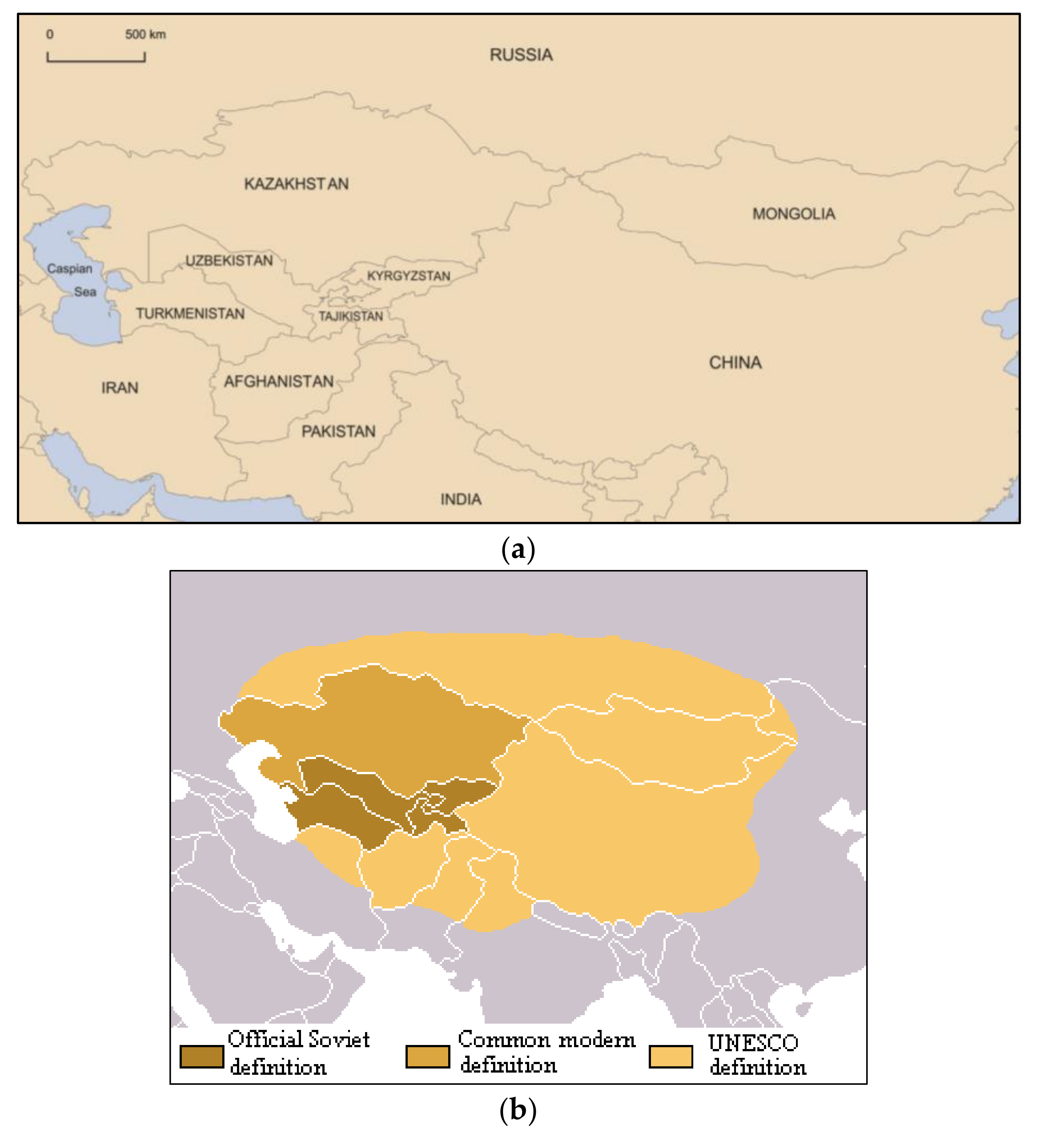
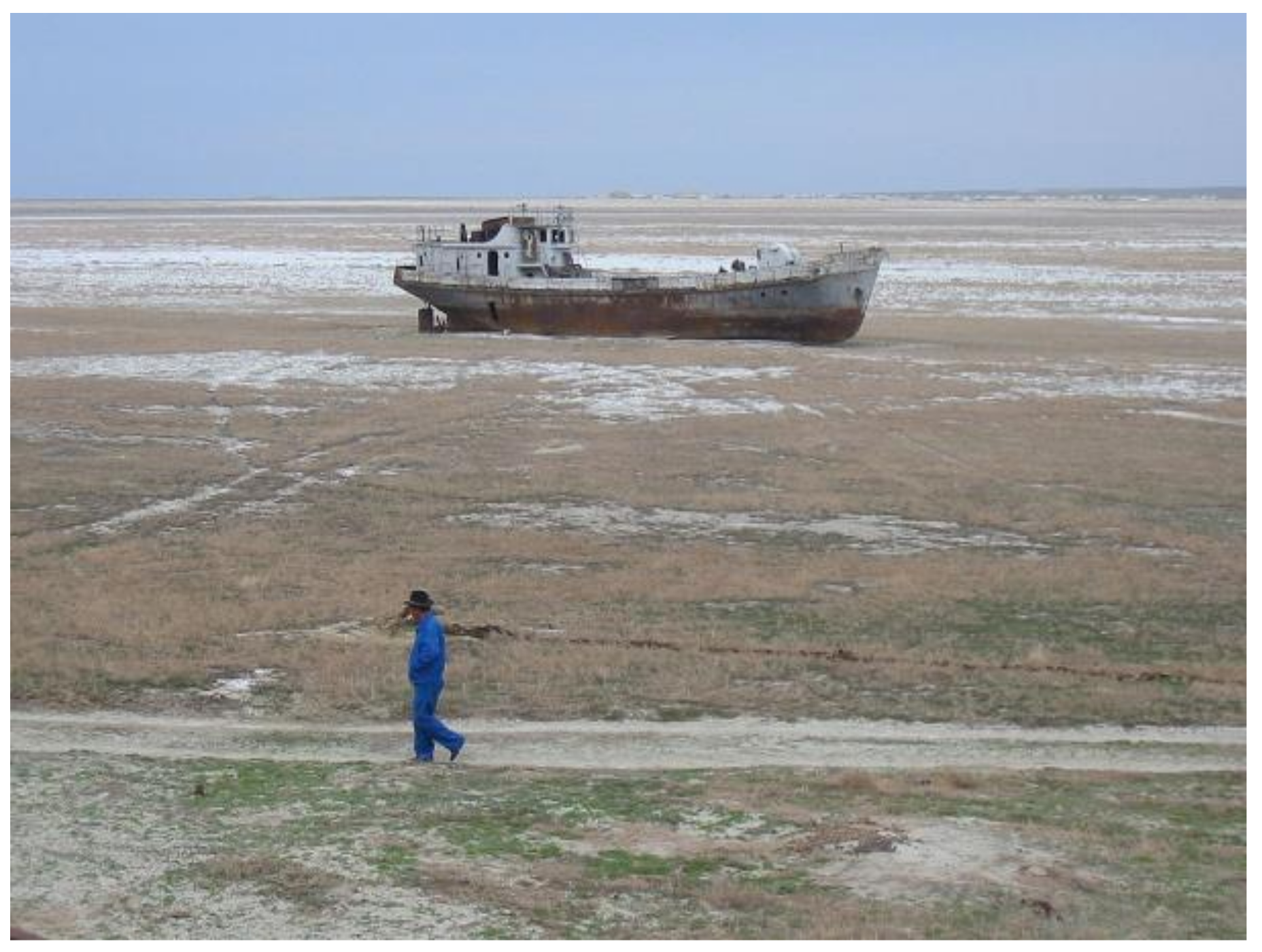
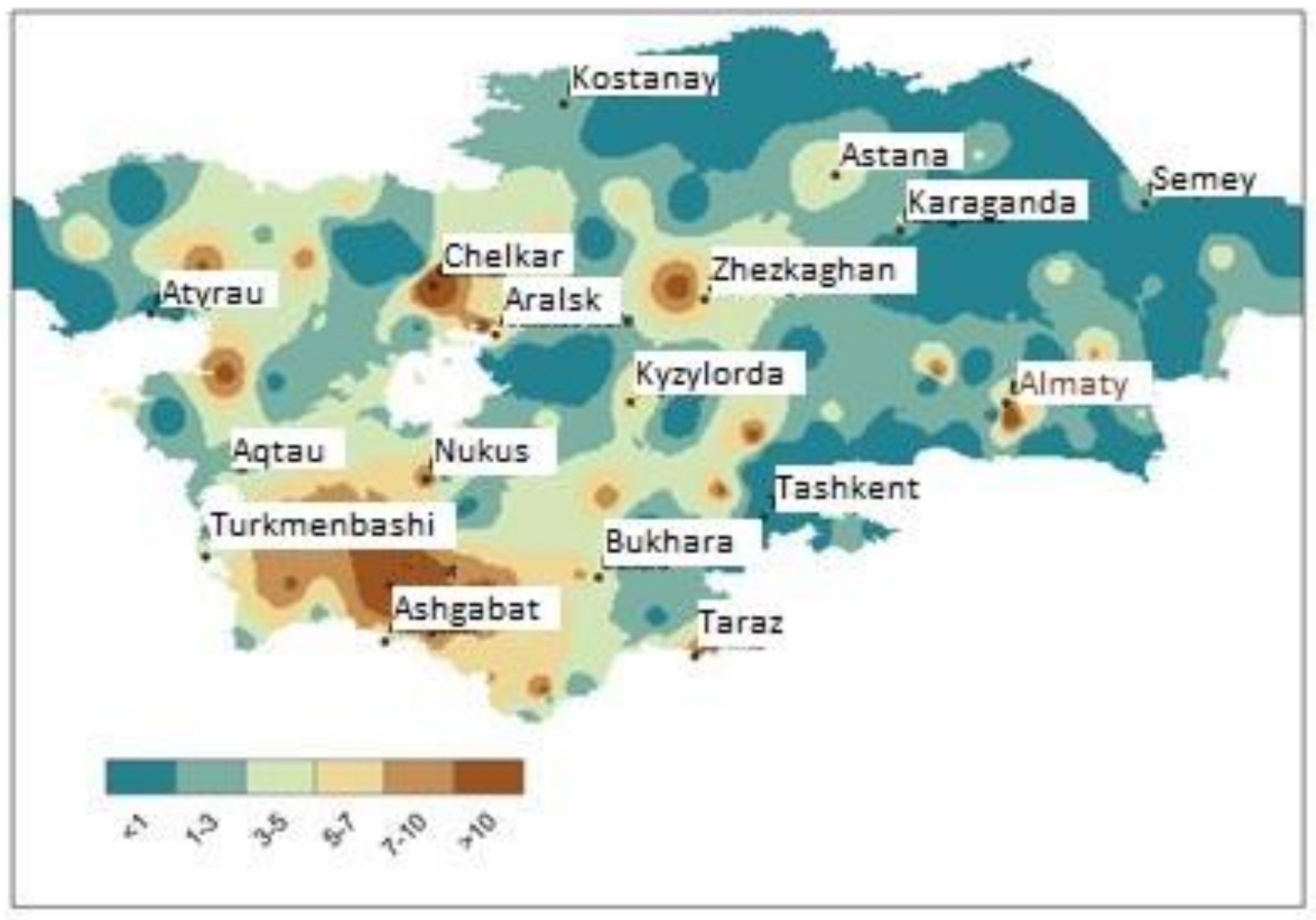
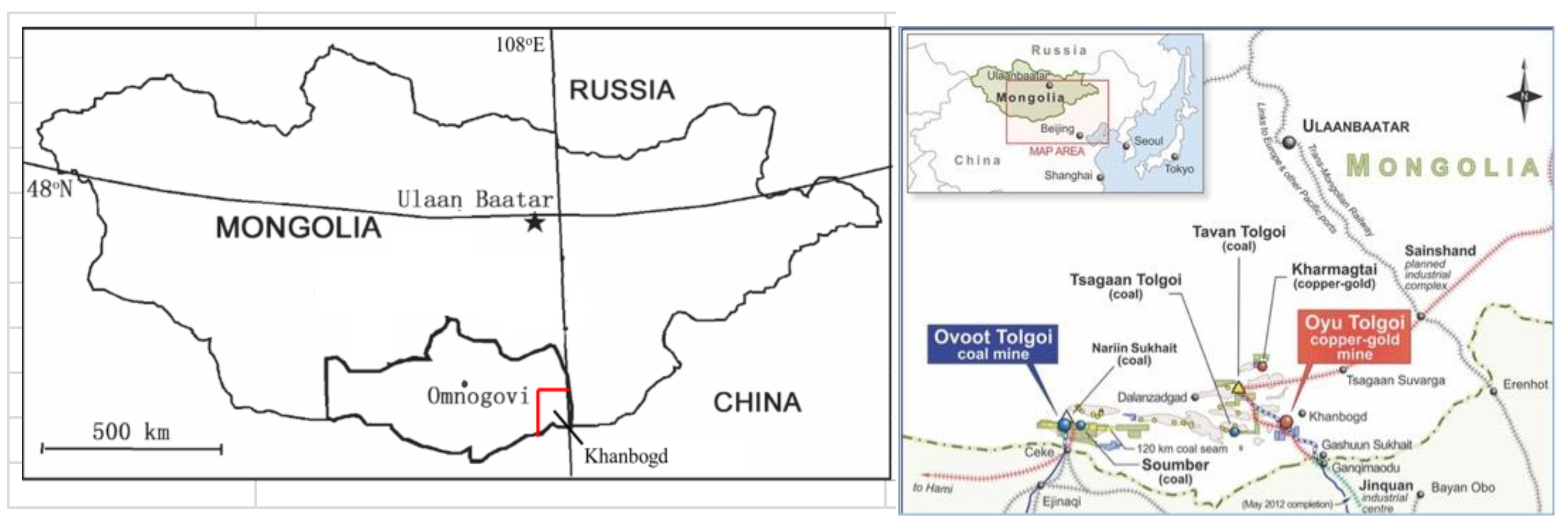
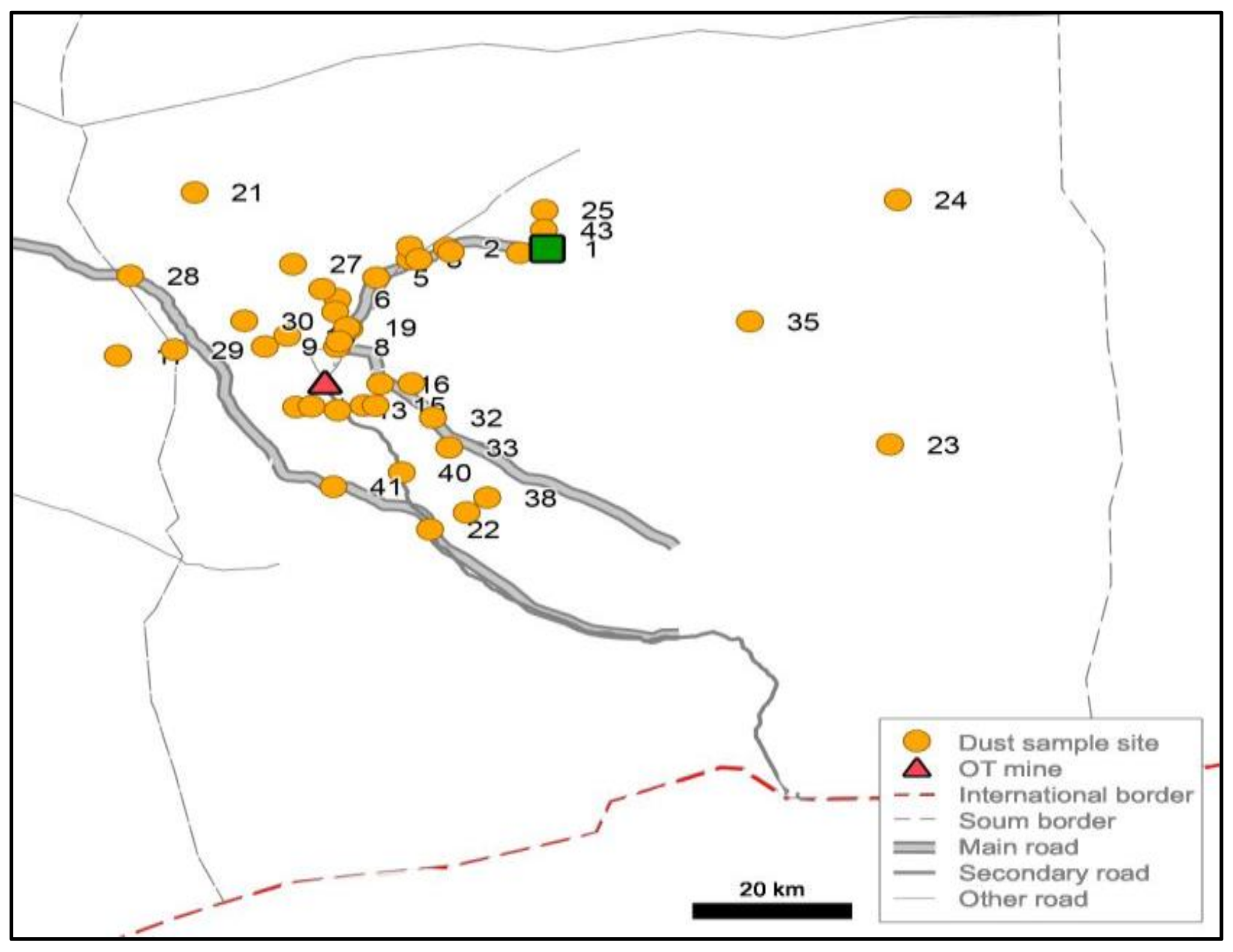
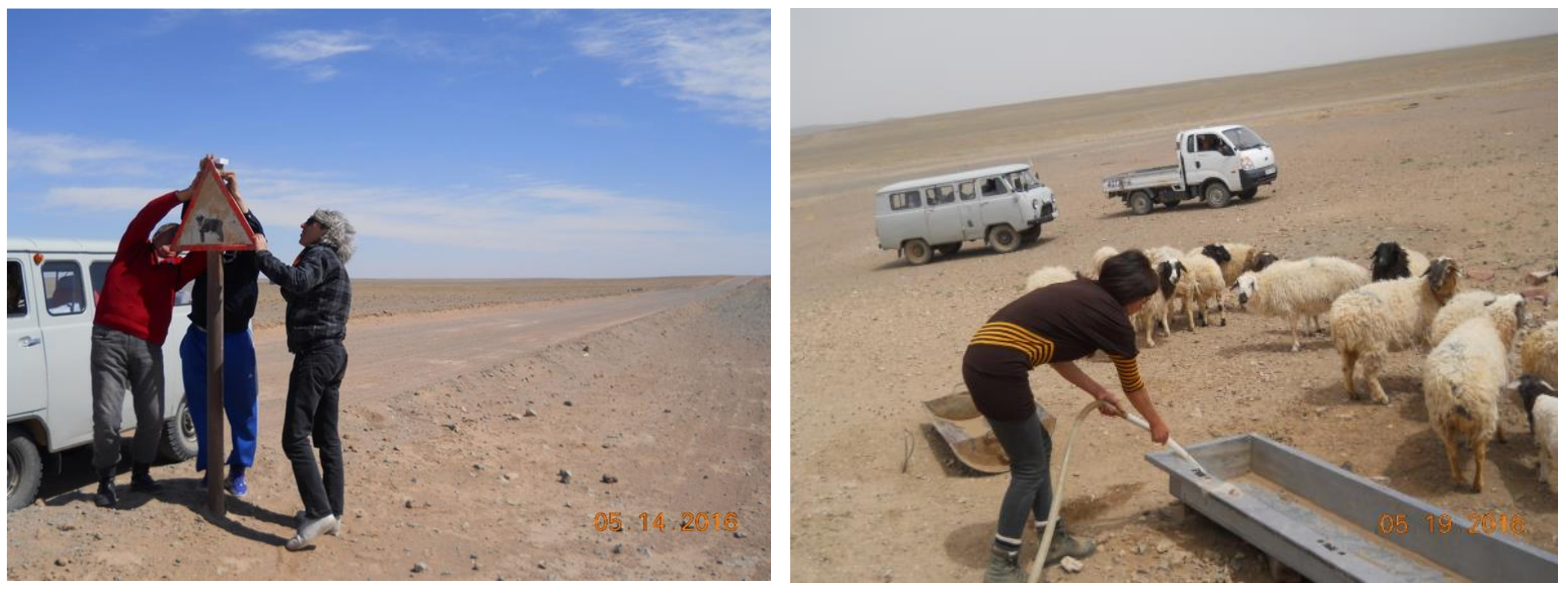
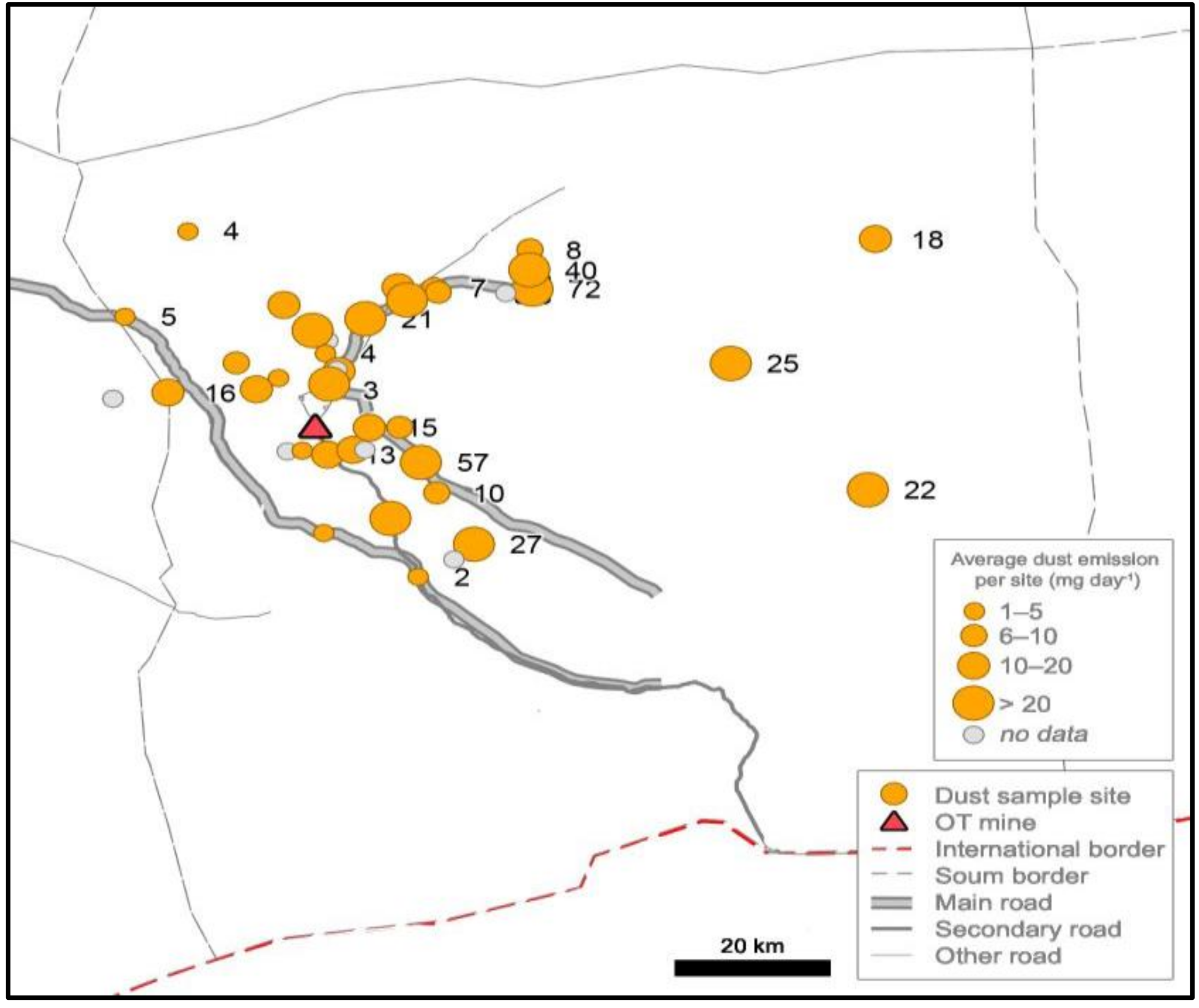
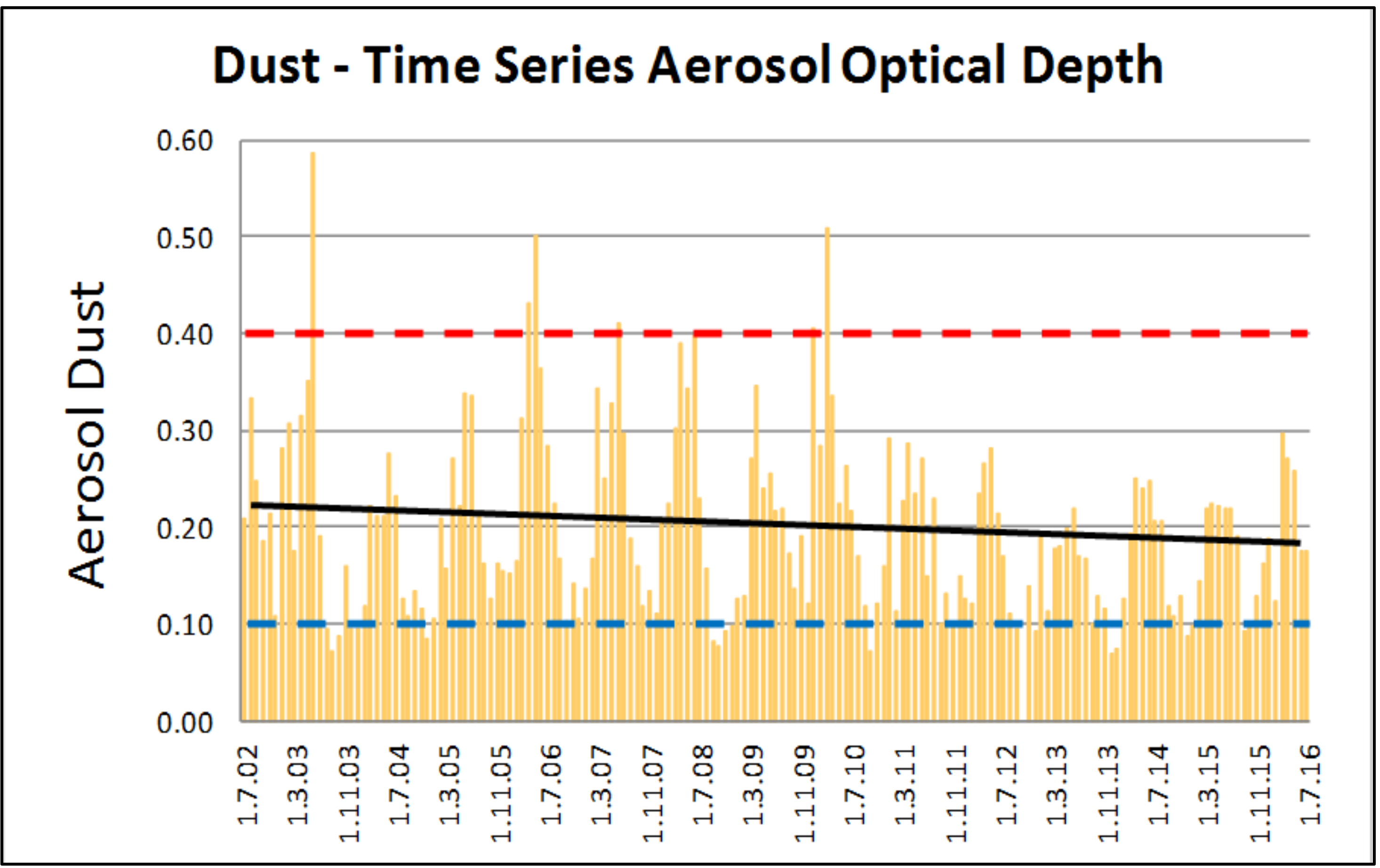
| Dust Sources | Causes-Physical | Causes-Human | Health Implications |
|---|---|---|---|
| Kyzyk Kum | Storms | Agriculture | Respiratory ailments |
| Kara Kum | - frequency | - irrigation | Lung disease |
| Taklamakan/Tarim | - intensity | - Virgin Lands programme | Cancer |
| Gobi (including Badain Jaran, Tengger, Hexi, Junggar, Mu Us etc.) | Climate change | - abandoned crops | Pneumonia |
| Dried Aral Sea | Livestock grazing | Digestive ingestion | |
| Drought | Salinity | - dust, salt | |
| Aral Kum | Wind | Pollution, contaminants | Eye, throat ailments |
| Moiyn Kum | Seasonality | Degradation | Malaria zones |
| Betpak Dash | Reduced vegetation/forest cover | Ground water depletion | Conjunctivitis |
| Pre-Balkash | Dessication of lakes | Off-road tracks | Menningitis |
| Turan Plain | Reduced soil moisture | Development, infrastructure | Cardovascular |
| Article | Topic | Author |
|---|---|---|
| Correlation between dust events in Mongolia and surface wind and precipitation. | Dusty days, strong winds and precipitatioin | Amgalan et al. 2017 [95] |
| Silica Dust from the enrich mining plant … origin in livestock | Mining dust impact on livestock | Tsetsegmaa 2004 [96] |
| Occupational lung diseases and the mining industry in Mongolia | Mining dust impact on humans | Lkhasuren et al. 2007 [97] |
| Environmental Review of Umnugobi Province and Negative Influence of Mining Industry to Livestock Health | Mining impact on livestock health | Orgil et al. 2011 [98] |
| Southern Gobi regional environmental assessment | Dust in the environment | World Bank 2010 [99] |
| Impact of the environment on health in Mongolia | Natural dust, mining-related dust | Jadambaa et al. [65] |
| Bringing health impact assessment to the Mongolian resource sector | Mining dust impact on human health | Byambaa et al. 2014 [100] |
| Dusty roads and disconnection:perceptions of dust from unpaved mining roads in Mongolia’s South gobi province | Perceived dust impact from Oyu tolgoi mine | Jackson 2015 [80] |
| Dust Site | GPS N | GPS E | Depostion Rate per Day |
|---|---|---|---|
| 1 | 43.20 | 107.19 | 0.072 |
| 2 | 43.20 | 107.03 | 0.007 |
| 3 | 43.18 | 106.98 | 0.001 |
| 4 | 43.20 | 106.98 | 0.017 |
| 5 | 43.16 | 106.92 | 0.021 |
| 6 | 43.13 | 106.86 | n.s. |
| 7 | 43.11 | 106.86 | 0.004 |
| 8 | 43.06 | 106.86 | 0.003 |
| 9 | 43.06 | 106.75 | 0.015 |
| 10 | 43.08 | 106.78 | 0.002 |
| 11 | 42.97 | 106.80 | n.s. |
| 12 | 42.97 | 106.82 | 0.003 |
| 13 | 42.97 | 106.86 | 0.013 |
| 14 | 42.98 | 106.90 | 0.012 |
| 15 | 42.98 | 106.92 | n.s. |
| 16 | 43.01 | 106.93 | 0.015 |
| 17 | 43.05 | 106.52 | n.s. |
| 18 | 43.09 | 106.88 | 0.011 |
| 19 | 43.09 | 106.88 | n.s. |
| 20 | 43.19 | 107.04 | 0.009 |
| 21 | 43.28 | 106.64 | 0.004 |
| 22 | 42.80 | 107.01 | 0.002 |
| 23 | 42.92 | 107.73 | 0.022 |
| 24 | 43.27 | 107.74 | 0.018 |
| 25 | 43.25 | 107.19 | 0.008 |
| 26 | 43.19 | 107.15 | n.s. |
| 27 | 43.18 | 106.79 | 0.019 |
| 28 | 43.16 | 106.54 | 0.005 |
| 29 | 43.06 | 106.61 | 0.016 |
| 30 | 43.10 | 106.72 | 0.007 |
| 31 | 43.01 | 106.98 | 0.01 |
| 32 | 42.96 | 107.01 | 0.057 |
| 33 | 42.92 | 107.04 | 0.01 |
| 34 | 43.14 | 106.84 | 0.022 |
| 35 | 43.10 | 107.51 | 0.025 |
| 36 | 43.18 | 106.99 | 0.083 |
| 37 | 43.05 | 106.52 | n.s. |
| 38 | 42.84 | 107.10 | 0.027 |
| 39 | 42.82 | 107.06 | n.s. |
| 40 | 42.88 | 106.96 | 0.075 |
| 41 | 42.86 | 106.86 | 0.005 |
| 42 | 43.07 | 106.87 | 0.076 |
| 43 | 43.23 | 107.19 | 0.04 |
© 2017 by the authors. Licensee MDPI, Basel, Switzerland. This article is an open access article distributed under the terms and conditions of the Creative Commons Attribution (CC BY) license (http://creativecommons.org/licenses/by/4.0/).
Share and Cite
Sternberg, T.; Edwards, M. Desert Dust and Health: A Central Asian Review and Steppe Case Study. Int. J. Environ. Res. Public Health 2017, 14, 1342. https://doi.org/10.3390/ijerph14111342
Sternberg T, Edwards M. Desert Dust and Health: A Central Asian Review and Steppe Case Study. International Journal of Environmental Research and Public Health. 2017; 14(11):1342. https://doi.org/10.3390/ijerph14111342
Chicago/Turabian StyleSternberg, Troy, and Mona Edwards. 2017. "Desert Dust and Health: A Central Asian Review and Steppe Case Study" International Journal of Environmental Research and Public Health 14, no. 11: 1342. https://doi.org/10.3390/ijerph14111342
APA StyleSternberg, T., & Edwards, M. (2017). Desert Dust and Health: A Central Asian Review and Steppe Case Study. International Journal of Environmental Research and Public Health, 14(11), 1342. https://doi.org/10.3390/ijerph14111342





